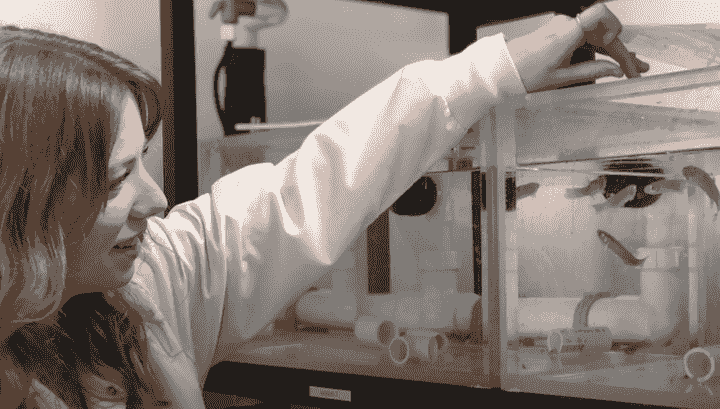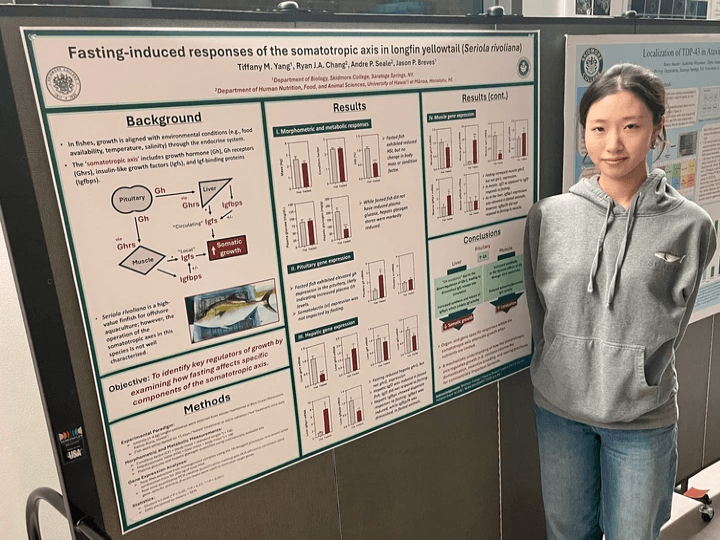
Laboratory of Comparative Physiology
Jason P. Breves
Professor of Biology
Skidmore College
- …
Laboratory of Comparative Physiology
Jason P. Breves
Professor of Biology
Skidmore College
- …
Laboratory of Comparative Physiology
Jason P. Breves
Professor of Biology
Skidmore College
Our objective is to understand how the endocrine system enables animals to thrive in dynamic environments.
- Research -
Vertebrate endocrine systems are key controllers of the physiological processes that maintain homeostasis. Hormones are secreted from specialized cells and glands in response to dynamic external and/or internal conditions. These changes in hormone levels initiate adaptive responses aimed at returning the organism to homeostasis. Our research seeks to build a mechanistic understanding of how the endocrine system aligns adaptive phenotypes with environmental circumstances.
Fishes experience significant challenges in maintaining homeostasis in the presence of large, and often variable, osmotic and salt gradients with the external environment. In turn, they have evolved efficient mechanisms to detect changes in internal and external salt conditions to initiate subsequent physiological responses. We leverage a variety of fish models (e.g., Mozambique tilapia, Atlantic salmon, mummichog, longfin yellowtail, and zebrafish) to explore how cellular and molecular processes underlie the physiology, development, and natural histories of animals residing in dynamic environments.
The first major theme of our research is to understand how pituitary hormones regulate organs that maintain hydromineral balance of the organism, namely the gill, kidney, urinary bladder, and gastrointestinal tract. We are particularly focused on identifying ion pumps, transporters, and channels regulated by prolactin signaling (see Breves et al., 2014, Breves et al., 2020 and Breves & Shaughnessy, 2024). Furthermore, specialized ion-transporting cells within the gill, coined "ionocytes", mount osmotic stress responses when exposed to changes in environmental salinity. We are currently investigating the interplay between cellular stress responses and systemic prolactin signaling to contribute mechanistic insight into how hormones control vertebrate epithelial tissues.
The sensitivity of prolactin-secreting cells in the tilapia pituitary gland to variations in extracellular osmolality enables investigations into how osmoreception underlies adaptive patterns of hormone secretion. While prolactin is firmly established as a necessary factor for osmoregulation in freshwater environments, it remains unknown how osmoreceptive processes orchestrate the expression of multiple prolactin-encoding genes. The second major theme of our research is to therefore link molecular aspects of cellular osmoreception with the regulation of prolactin gene promoters (see Seale et al., 2020). Based on our findings, other vertebrate genomes can be searched for essential promoter regions and transcription factors that respond to shifts in extracellular osmolality.
Finally, the third major theme of our research is to understand how the somatotropic axis (the growth hormone/insulin-like growth-factor system) matches growth patterns with environmental conditions. More specifically, we focus on how stressors, nutrition, salinity, and xenobiotics influence the expression of insulin-like growth-factor binding proteins in Atlantic salmon, tilapia, and longfin yellowtail (see Breves et al., 2018, Breves et al., 2020, and this short animation). Atlantic salmon life-history transitions are deeply interconnected with somatic growth patterns and body size underlies overall fitness at key stages. A nuanced understanding of how growth is regulated equips physiologists to better interpret the growth patterns in wild fish and optimize restoration strategies for endangered populations.
Recent coverage in Skidmore's SCOPE magazine: HERE
- Recent Publications -
The effects of tidally changing salinities on branchial tight junction protein gene expression in tilapia
Gardi Hewage Tharindu Malintha, Ke Cao, Fritzie T. Celino-Brady, Jason P. Breves, Andre P. Seale
Comparative Biochemistry and Physiology - Part A (2026) 311: 111956. PDF
Thermal tolerance plasticity of Fundulus heteroclitus is maintained in freshwater and fluctuating temperature conditions
Michelle Y. Monette, Steven Pancurak, Jason P. Breves
Journal of Comparative Physiology B (2025) In press. PDF
Salt-secreting ionocytes in marine fishes: new dimensions and evolutionary implications of a fundamental model
Ciaran A. Shaughnessy, Jason P. Breves
Journal of Experimental Biology (2025) 228: jeb251075. PDF
TRPA1 activation blunts the somatotropic axis in ectothermic fish
Jason P. Breves
Endocrinology (2025) 166(4): bqaf039. PDF
A Cftr-independent, Ano1-rich seawater-adaptive ionocyte in sea lamprey gills
Ciaran A. Shaughnessy, Daniel J. Hall, Jessica L. Norstog, Andre Barany, Amy M. Regish, Diogo Ferreira-Martins, Jason P. Breves, Lisa M. Komoroske, Stephen D. McCormick
Journal of Experimental Biology (2025) 228: jeb250110. PDF
Environmental salinity differentially impacts branchial and hepatic carbohydrate metabolism in tilapia
Ryan J.A. Chang, Fritzie T. Celino-Brady, Jason P. Breves, Andre P. Seale
Journal of Fish Biology (2025) 107: 932-945. PDF
Hypersalinity tolerance of mummichogs (Fundulus heteroclitus): A branchial transcriptomic analysis
Yixuan T. Tao, Jason P. Breves
Comparative Biochemistry and Physiology - Part D (2024) 52: 101338. PDF
Salinity and prolactin regulate anoctamin 1 in the model teleost, Fundulus heteroclitus
Jason P. Breves, Mariana A. Posada, Yixuan T. Tao, Ciaran A. Shaughnessy
American Journal of Physiology - Regulatory, Integrative and Comparative Physiology (2024) 327: R479-485. PDF
Endocrine control of gill ionocyte function in euryhaline fishes
Transcriptional regulation of esophageal, intestinal, and branchial solute transporters by salinity, growth hormone, and cortisol in Atlantic salmon
Jason P. Breves, Ellie R. Runiewicz, Sierra G. Richardson, Serena E. Bradley, Daniel J. Hall, Stephen D. McCormick
Journal of Experimental Zoology A (2024) 341: 107-117. PDF
Sex-specific responses to growth hormone and luteinizing hormone in a model teleost, the Mozambique tilapia
Fritzie T. Celino-Brady, Jason P. Breves, Andre P. Seale
General and Comparative Endocrinology (2022) 329: 114119. PDF
Na+/HCO3- cotransporter 1 (nbce1) isoform gene expression during smoltification and seawater acclimation of Atlantic salmon
Jason P. Breves, Ian S. McKay, Victor Koltenyuk, Nastasia N. Nelson, Sean C. Lema, Stephen D. McCormick
Endocrine and osmoregulatory responses to tidally-changing salinities in fishes
Andre P. Seale, Jason P. Breves
General and Comparative Endocrinology (2022) 326: 114071. PDF
Tilapia prolactin cells are thermosensitive osmoreceptors
Daniel W. Woo, Gardi Hewage Tharindu Malintha, Fritzie T. Celino-Brady, Yoko Yamaguchi, Jason P. Breves, Andre P. Seale
American Journal of Physiology - Regulatory, Integrative and Comparative Physiology (2022) 322: R609-619. PDF
Molecular targets of prolactin in mummichogs (Fundulus heteroclitus): Ion transporters/channels, aquaporins, and claudins
Jason P. Breves, Katie M. Puterbaugh, Serena E. Bradley, Annie E. Hageman, Adrian J. Verspyck, Lydia H. Shaw, Elizabeth C. Danielson, Yubo Hou
Regulation of thyroid hormones and branchial iodothyronine deiodinases during freshwater acclimation in tilapia
Lucia A. Seale, Christy L. Gilman, Ann Marie Zavacki, P. Reed Larsen, Mayu Inokuchi, Jason P. Breves, Andre P. Seale
Molecular and Cellular Endocrinology (2021) 538: 111450. PDF
Enhanced expression of ncc1 and clc2c in the kidney and urinary bladder accompanies freshwater acclimation in Mozambique tilapia
Jason P. Breves, Nastasia N. Nelson, Victor Koltenyuk, Cody K. Petro-Sakuma, Fritzie T. Celino-Brady, Andre P. Seale
Comparative Biochemistry and Physiology - Part A (2021) 260: 111021. PDF
Molecular mechanisms of Cl- transport in fishes: New insights and their evolutionary context
Ciaran A. Shaughnessy, Jason P. Breves
Journal of Experimental Zoology - Part A (2021) 335: 207-216. PDF
Transcriptional regulation of prolactin in a euryhaline teleost: Characterization of gene promoters through in silico and transcriptomic analyses
Andre P. Seale, Gardi Hewage Tharindu Malintha, Fritzie T. Celino-Brady, Tony Head, Mahdi Belcaid, Yoko Yamaguchi, Darren T. Lerner, David A. Baltzegar, Russell J. Borski, Zoia R. Stoytcheva, Jason P. Breves
Journal of Neuroendocrinology (2020) 32: e12905. PDF
Osmoregulatory actions of prolactin in the gastrointestinal tract of fishes
Jason P. Breves, Emily E. Popp, Eva F. Rothenberg, Clarence W. Rosenstein, Kaitlyn M. Maffett, Rebecca R. Guertin
General and Comparative Endocrinology (2020) 298: 113589. PDF
Cortisol regulates insulin-like growth-factor binding protein (igfbp) gene expression in Atlantic salmon parr
Jason P. Breves, Ryan H. Springer-Miller, Demaris A. Chenoweth, Amanda L. Paskavitz, Annaliese Y. H. Chang, Amy M. Regish, Ingibjorg E. Einarsdottir, B. Thrandur Bjornsson, Stephen D. McCormick
Molecular and Cellular Endocrinology (2020) 518: 110989. PDF
Growth hormone regulates intestinal gene expression of nutrient transporters in tilapia (Oreochromis mossambicus)
Cody Petro-Sakuma, Fritzie T. Celino-Brady, Jason P. Breves, Andre P. Seale
General and Comparative Endocrinology (2020) 292: 113464. PDF
Salinity dependent expression of ncc2 in opercular epithelium and gill of mummichog (Fundulus heteroclitus)
Jason P. Breves, Julie A. Starling, Christine M. Popovski, James M. Doud, Christian K. Tipsmark
Journal of Comparative Physiology B (2020) 190: 219-230. PDF
Hormonal control of aquaporins in fishes
Jason P. Breves
In: Litwack, G (Ed.), Aquaporin Regulation, Vitamins and Hormones (2020) 112: 265-287. PDF
- Teaching -
Recent Courses @ Skidmore College

BI 108
Organismal Biology
This course introduces the processes that shape and regulate individuals, populations, communities, and ecosystems. Students develop foundational knowledge of evolutionary theory and, from this perspective, explore topics in organismal biology with an emphasis on physiology and ecology.
BI 244
Comparative Vertebrate Physiology
The primary objective of this course is to compare and contrast the functions of key physiological systems in the major vertebrate taxonomic groups (jawless fishes, cartilaginous fishes, bony fishes, amphibians, reptiles, birds, and mammals). Students are challenged to understand the mechanisms that support environmental adaptation at multiple levels of biological organization and the selection pressures that underlie their evolution.
BI 306
Mammalian Physiology
This course is designed for upper-division students to concentrate on the physiological systems that maintain homeostasis in mammals. The physiological functions of these systems are further considered in light of their association with human and animal diseases. This course also takes the opportunity to explore specialized physiologies which evolved within the mammalian lineage (e.g., lactation).
BI 343
Endocrinology
This advanced physiology course concentrates on how hormones coordinate fundamental processes in vertebrates such as growth, development, metabolism, stress, and reproduction. Through the comparative approach students garner an understanding of how hormone actions evolved during the course of vertebrate evolution and how knowledge of these actions is leveraged in diverse fields. This course encompasses topics in endocrinology that reach from the physiology of wild animals to the etiology of human diseases. In this particular course, guest speakers play an important role in communicating the varied career paths that individuals pursue within the field of endocrinology.
“Professor and student learn from each other; it is a two-way interaction.…The differences between professor and student that derive from age, gender, economic status, ethnicity, experience, philosophy, etc., assure that both will be exposed to new ideas and attitudes.”
Prof. Howard Bern, Comparative Endocrinologist
- People -

Jason P. Breves (Primary Investigator)
Following the completion of a M.S. at the University of Rhode Island with Dr. Jennifer Specker, Dr. Breves obtained his Ph.D. in 2010 from the University of Hawaii under the co-supervision of Drs. Gordon Grau and Tetsuya Hirano. As an NIH postdoctoral fellow, Dr. Breves conducted research at the Center for Neuroendocrine Studies at the University of Massachusetts Amherst and the Conte Anadromous Fish Research Center (U.S. Geological Survey). Dr. Breves is currently a Professor of Biology at Skidmore College. He is the recipient of several early-career awards from the Comparative and Evolutionary Physiology Section of the American Physiological Society and the North American Society for Comparative Endocrinology. Dr. Breves was awarded the Grace E. Pickford Medal from the International Federation of Comparative Endocrinological Societies in 2025.
Research Students (Current and Alumni)
Raisa Bonner '20, Serena Bradley '23, Annaliese Chang '19, Damaris Chenoweth '17, Charlotte Dale '27, Libby Danielson '23, James Doud '17, Chelsea Fujimoto '15, Rachel Golden '18, Vicky Grechukhina '27, Annie Hageman '23, Alexandra Harney '21, Olivia Hayden '17, Bethany Hunt '17, Paige Keith '16, Victor Koltenyuk '20, Emma Laquinta '25, Ian McKay '20, Nastasia Nelson '20, Amanda Paskavitz '17, Silas Phipps-Costin '16, Carissa Pienkowski '24, Christine Popovski '16, Mariana Posada '25, Katie Puterbaugh '23, Sierra Richardson '23, Eleanore Ritter '18, Ellie Runiewicz '24, Lydia Shaw '22, Ryan Springer-Miller '17, Yixuan Tao '24, Stephanie Uraga '22, Adrian Verspyck '22, Rebecca White '19, Tiffany Yang '26, Ketan Yerneni '17, Wenhui Zhao '18

Tiffany Yang '26
Tiffany presents work describing how various components of the somatotropic axis in longfin yellowtail respond to nutrient availability.

Emma Laquinta '25
Emma nets an Atlantic salmon at the Conte Anadromous Fish Research Center (U.S. Geological Survey).

Carissa Pienkowski '24 & Yixuan Tao '24
Carissa and Thomas are seemingly running PCRs until the very end. That's dedication!

Ellie Runiewicz '24
Ellie was awarded 2nd Place in a trainee poster competition sponsored by the Comparative and Evolutionary Physiology Section of the American Physiological Society. She was presented the award at the 2023 American Physiology Summit.

Serena Bradley '23, Annie Hageman '23, Katie Puterbaugh '23, Adrian Verspyck '22
The crew and our collaborator, Dr. Stephen McCormick, check on an experiment during a visit to the Conte Anadromous Fish Research Center (U.S. Geological Survey).

Lydia Shaw '22
Lydia feeds a colony of mummichog maintained in a recirculating system housed within the 'Aquatics Facility' of the Center for Integrated Sciences.

Nastasia Nelson '20
Nastasia characterizes the gene expression of solute transporters in the kidney and urinary bladder of Mozambique tilapia responding to changes in environmental salinity.

Victor Koltenyuk '20
Victor is reverse transcribing RNA purified from Atlantic salmon gills collected during their springtime preparation for seawater entry.

Annaliese Chang '19
Annaliese presents her poster on the effects of corticosteroids on the somatotropic axis of Atlantic salmon parr at the 2019 Experimental Biology Conference in Orlando, FL. Annaliese's poster was awarded second place in the Scholander Award Session held by the Comparative and Evolutionary Physiology Section of the American Physiological Society.

Becca White '19
Becca describes how steroid hormones regulate activities within the somatotropic axis of Atlantic salmon smolts acclimated to seawater and freshwater. Becca presented her findings at the 2019 Experimental Biology Conference in Orlando, FL.

Ryan Springer-Miller '17
Ryan presents her poster on how cortisol impacts salmon growth via insulin-like growth-factor binding proteins within the Comparative and Evolutionary Physiology Section at the 2017 Experimental Biology Conference in Chicago, IL.
- Collaborators -
Andre Seale (Univ. of Hawaii, USA)
Stephen McCormick (U.S. Geological Survey, USA)
B. Thrandur Bjornsson (Univ. of Gothenburg, Sweden)
Mayu Inokuchi (Toyo Univ., Japan)
Sean Lema (Cal Poly San Luis Obispo, USA)
Yoko Yamaguchi (Shimane Univ., Japan)
William Marshall (St. Francis Xavier Univ., Canada)
Michelle Monette (Western Connecticut State Univ., USA)
Darren Lerner (Univ. of Hawaii SeaGrant, USA)
Ciaran Shaughnessy (Oklahoma State Univ., USA)
Ming-Wen Hu (Johns Hopkins Univ., USA)
Russell Borski (North Carolina State Univ., USA)

- Recent Funding -
Primary Investigator:
Identifying osmosensitive molecular targets using a unique vertebrate model
Co-Primary Investigator:
MRI: Acquisition of a Seahorse XFe96 Analyzer for high-throughout measurements of glycolysis and mitochondrial respiration at Skidmore College
Co-Primary Investigator:
MRI: Acquisition of field emission scanning electron microscope and energy dispersive spectrometry attachment for high resolution imaging at Skidmore College
- Contact -






































